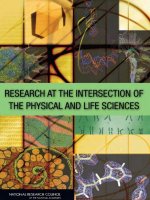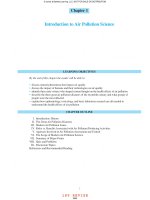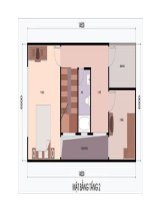5 2 cells to systems (life science)
Bạn đang xem bản rút gọn của tài liệu. Xem và tải ngay bản đầy đủ của tài liệu tại đây (3.09 MB, 10 trang )
Life Science
Genre
Nonfiction
Comprehension Skill
Draw Conclusions
Text Features
•
•
•
•
Labels
Captions
Diagrams
Glossary
Science Content
Cells to Systems
Scott Foresman Science 5.2
ISBN 0-328-13919-X
ì<(sk$m)=bdjbje< +^-Ä-U-Ä-U
by Erika Alexander
Vocabulary
What did you learn?
cell membrane
1. What are some things that cells need that you need too?
cell wall
chloroplast
cytoplasm
nucleus
Cells to Systems
by Erika Alexander
2. Why do nerve cells have long, branching shapes?
3. Name three important jobs that your bones do.
4.
Every cell in your body needs food.
On your own paper, write to explain how the food gets to
each of your cells.
5.
Draw Conclusions Your bones and muscles work to
let you move. What do you think would happen if you didn’t
have any bones? or if you didn’t have any muscles?
organ
organ system
tissue
vacuole
Illustrations: Title Page, 5, 7, 9, 12, 15 Leonello Calvetti
Photographs: Every effort has been made to secure permission and provide appropriate credit for
photographic material. The publisher deeply regrets any omission and pledges to correct errors called to its
attention in subsequent editions. Unless otherwise acknowledged, all photographs are the property of Scott
Foresman, a division of Pearson Education. Photo locators denoted as follows: Top (T), Center (C), Bottom
(B), Left (L), Right (R) Background (Bkgd)
Opener: ©Dr. Fred Hossler/Visuals Unlimited 2 (BR) ©Dr. Fred Hossler/Visuals Unlimited, (Bkgd)
©Michael Webb/Visuals Unlimited; 6 (BL) ©Dr. Dennis Kunkel/Visuals Unlimited, (BC, BR) ©David
Phillips/Visuals Unlimited; 7 (CL) ©Susumu Nishinaga/Photo Researchers, Inc., (CR) ©RDF/Visuals
Unlimited, (CL) ©Dr. Dennis Kunkel/Visuals Unlimited; 8 (BL) ©Quest/Photo Researchers, Inc., (CR)
©Veronika Burmeister/Visuals Unlimited; 11 (TL) ©Dr. Fred Hossler/Visuals Unlimited, (CC) ©Dr. Richard
Kessel & Dr. Randy Kardon/Visuals Unlimited, (BL) ©Dr. Donald Fawcett/Visuals Unlimited
ISBN: 0-328-13919-X
Copyright © Pearson Education, Inc.
All Rights Reserved. Printed in the United States of America. This publication is
protected by Copyright and permission should be obtained from the publisher prior
to any prohibited reproduction, storage in a retrieval system, or transmission in any
form by any means, electronic, mechanical, photocopying, recording, or likewise. For
information regarding permissions, write to: Permissions Department, Scott Foresman,
1900 East Lake Avenue, Glenview, Illinois 60025.
3 4 5 6 7 8 9 10 V010 13 12 11 10 09 08 07 06 05
What is inside a cell?
Cells and Their Functions
A cell is the smallest living part of any living thing. Some
organisms have only a single cell. Animals and plants may
have trillions. Most cells are so small they can’t be seen without
a microscope.
Cells have the same needs as all life forms, and they contain
tiny parts to help them meet their needs. Cells need food to
survive, just like you. All cells have parts that move inside of
them, and some cells can even move on their own. Cells can
respond to changes around them, and can even communicate
with other cells to get a job done.
2
Cells use materials in food to grow and to repair wounds.
Cells also need energy. They mix food with oxygen to get
energy. This process is called respiration. Carbon dioxide and
water are also made by this process. The energy that cells make
is used for growing, moving, and dividing into new cells.
3
The Parts of Cells
The Size of Cells
All cells have some of the same parts. Each part has a special
job to do. Many of the jobs are similar to the jobs our larger
body parts do. For example, you have skin to protect you, a
digestive system to process food, and a system of nerves to
control everything.
The cell membrane, which surrounds the cell, acts like a
gate. It opens to let food and oxygen in and to let wastes out.
The nucleus of a cell contains chromosomes. Chromosomes
are made of DNA, a chemical that is shaped like a twisted
ladder. The chromosomes carry the information a cell needs
to do its job. Each chromosome has sections called genes that
carry units of information. Almost every cell in your body has
the same genes. These genes pass from one generation to the
next in a process called heredity.
Plant cells have some special parts that animal cells do
not have. They have a tough cell wall surrounding their cell
membrane. This gives plants extra support. They also have
chloroplasts, which plants use to make food. Chloroplasts
use sunlight to turn water and carbon dioxide into sugar and
oxygen. The plant gets its energy from the sugar.
Cells must be big enough to hold all their parts, but not too
big. If a cell is too big, food and oxygen are not able to reach
the middle of the cell fast enough to keep it alive.
Mitochondria combine
oxygen and food to
produce energy in
the process of cellular
respiration.
Almost every cell
nucleus in your body
has 46 chromosomes.
Cytoplasm is all the material of the
cell between the cell membrane
and the nucleus.
4
Vacuoles sometimes
break down and
store material. In
plant cells, they
may store water.
The cell membrane
can be compared
to your skin.
5
How do cells work together?
Types of Cells and Their Work
The shapes of cells help them do different jobs. Some cells
have special parts to help them do their job.
Very long cells are called branching cells. Nerve cells have
branching shapes to help them send messages through the
body. Their great length allows signals to be sent very quickly
between different parts of the body.
Cells that have a smooth round shape are called round cells.
Red blood cells are round. They act like saucers to pick up and
carry oxygen. Their smooth shape helps them move through
blood vessels.
A third kind of cell is called a flat cell. These cells join
together to cover a surface. A layer of flat cells is very strong yet
flexible. Your skin is made of flat cells.
Special Cell
Structures
There are hairlike structures in
your ears that bend when sound
waves make vibrations. When
they bend, nerve signals travel to
your brain.
Muscle cells contain long
fibers. These fibers can move
to make the cell shorter. The
fibers are not very strong by
themselves. But they work
together in each cell. Then
many cells work together to
make the muscle strong.
This nerve cell is a
branching cell.
6
This red blood cell is
a round cell.
Cilia are some
other tiny hairlike
structures. Cilia wave
back and forth to
sweep dirt and germs
out of your airways.
This skin cell is a
flat cell.
7
Cells Form Tissues
Skin Cell Tissue
Often the same kind of cells work together to do the same
job. When cells work together, they form a tissue. Nerve cells
work together to form nerve tissue. A group of bone cells make
up bone tissue.
Skin cells form in
many layers. The top
section alone has about
25 layers! New cells
form in the bottom layer
and push the other cells
outward and away from
the blood supply. Cells
are dead when they
reach the surface. Dead
cells simply fall off, but they
are always being replaced by
new cells from below. It takes about
one month for skin cells to be pushed
to the surface.
Tissues Form Organs
Tissues join with other tissues to form organs. Your body’s
organs do many important jobs. Your heart, eyes, ears, and
stomach are all organs. Your skin is the largest organ you have.
Plants have tissues and organs too. Plant organs include stems,
roots, leaves, and flowers.
Hair follicle
Hair forms inside cells in
hair follicles. As new cells
form, old ones are pushed
out. The hair you see is
dead tissue.
Sweat gland pore
Sweat leaves your skin
through pores. It then
evaporates from your
skin, helping to keep
you cool.
8
Other Tissues in the Skin
Your skin is more than just layers of flat skin cells. Skin has
many tissues working together to do many jobs. Your skin
prevents germs from entering your body. It also keeps too much
water from leaving. Nerve tissue allows your skin to sense
touch, pressure, and temperature. Oil glands make oil that
keeps your skin soft. The hair on your skin stands up when you
get cold, trapping air next to the skin to keep you warm. This
is what we call goosebumps. It is caused by muscles in the skin
pulling the hair upright.
9
How do organs work
together?
Organ Systems
Muscles work together.
Squeeze your fist tight. Several
muscles work together to make
your fingers form a fist. Can you
feel the muscles get tight in your
lower arm?
In your body, many cells work together in tissues. Many
tissues work together in organs. An organ system is a
group of organs that work together to perform important
jobs for your body.
Bones Form a System
Each of your bones is an organ. About two hundred
bones work together in your skeletal system. This system
supports your body. It also protects other organs from being
damaged.
Muscles Work as a System
Your muscles are part of a system too. The job
of your muscles is to move your body. Your body
has about 640 muscles in it. Different muscles
work together when your brain tells them you
want to run or jump. Sometimes muscles
work without your brain telling them to.
For example, if you are cold, your muscles
might shiver, helping to keep you warm.
You shiver without even thinking about it.
Bones work together.
This is a cutaway view of
where the bone in your leg
meets the bone in your hip.
10
Bone cells
Between the bone cells is a hard
material that has lots of calcium.
This material makes bones hard.
Other parts of the body, such as
muscles, also use calcium from
blood to do their work. Bones
store calcium until the level of
calcium in the blood is low.
11
Organ Systems Work Together
Sometimes organ systems need to work together to do more
difficult jobs. Your skeletal system and muscle system need to
work together so you can move. Your bones provide support,
and your muscles move your bones. You need both systems to
move your arm or any other part of your body.
Two or more muscles have the job of moving a bone in
opposite directions. Muscles move bones by pulling on them.
They never push.
Bone marrow
Other Systems Work Together
In your body, many systems must work together. For
example, you know that your muscles work with your bones to
make you move. But the muscles would not work if they didn’t
receive messages telling them what to do. Your nervous system
carries these messages from the brain and spinal cord.
Some organs might belong to two organ systems. Your heart
pumps your blood, so it is part of the circulatory system. But
it is also a muscle, so it is also part of your muscle system.
Your bones make up your skeletal system, but they also do an
important job for the circulatory system. A soft material called
marrow is found inside some of your bones. Marrow makes red
and white blood cells for the circulatory system.
12
13
Muscles Flex and Extend
When you bend your elbow, your biceps muscle pulls your
arm up. When you straighten your arm again, your triceps
muscles are pulling. Muscles work in pairs to bend your wrist
and rotate your arm too.
It is amazing to think about all the work that cells do in your
body. Tiny cells work together to form tissues. Tissues team up
and make organs. Your organs work with each other and form
organ systems. This teamwork is what makes it possible for
your body to do all the things you need it to do.
Biceps
Biceps
Triceps
14
Triceps
15
Vocabulary
Glossary
cell
cellmembrane
membrane
cell wall
cell wall
chloroplast
cytoplasm
chloroplast
nucleus
organ
cytoplasm
What did you learn?
surrounds the cell and allows things to pass
in and out
strong wall provides support and protection
for plant cells
green part of a plant cell that uses energy
from sunlight to turn water and carbon
dioxide into oxygen and sugar
organ system
everything between the cell membrane and
the nucleus
tissue
nucleus
the part of a cell that contains DNA
vacuole
organ
a group of different tissues that join
together to do a main job in the body
organ system
a group of organs that work together to do
an important job
tissue
a group of the same kind of cells working
together doing the same job
Illustrations: Title Page, 5, 7, 9, 12, 15 Leonello Calvetti
Photographs:
madepart
to secure
permission
andand
providebreaks
appropriate
credit for
vacuole Every effort has been
a cell
that
stores
down
photographic material. The publisher deeply regrets any omission and pledges to correct errors called to its
attention in subsequent editions. Unless
otherwise acknowledged, all photographs are the property of Scott
materials
Foresman, a division of Pearson Education. Photo locators denoted as follows: Top (T), Center (C), Bottom
(B), Left (L), Right (R) Background (Bkgd)
Opener: ©Dr. Fred Hossler/Visuals Unlimited 2 (BR) ©Dr. Fred Hossler/Visuals Unlimited, (Bkgd)
©Michael Webb/Visuals Unlimited; 6 (BL) ©Dr. Dennis Kunkel/Visuals Unlimited, (BC, BR) ©David
Phillips/Visuals Unlimited; 7 (CL) ©Susumu Nishinaga/Photo Researchers, Inc., (CR) ©RDF/Visuals
Unlimited, (CL) ©Dr. Dennis Kunkel/Visuals Unlimited; 8 (BL) ©Quest/Photo Researchers, Inc., (CR)
©Veronika Burmeister/Visuals Unlimited; 11 (TL) ©Dr. Fred Hossler/Visuals Unlimited, (CC) ©Dr. Richard
Kessel & Dr. Randy Kardon/Visuals Unlimited, (BL) ©Dr. Donald Fawcett/Visuals Unlimited
ISBN: 0-328-13919-X
Copyright © Pearson Education, Inc.
All Rights Reserved. Printed in the United States of America. This publication is
protected by Copyright and permission should be obtained from the publisher prior
to any prohibited reproduction, storage in a retrieval system, or transmission in any
form by any means, electronic, mechanical, photocopying, recording, or likewise. For
information regarding permissions, write to: Permissions Department, Scott Foresman,
1900 East Lake Avenue, Glenview, Illinois 60025.
3 4 5 6 7 8 9 10 V010 13 12 11 10 09 08 07 06 05
16
1. What are some things that cells need that you need too?
2. Why do nerve cells have long, branching shapes?
3. Name three important jobs that your bones do.
4.
Every cell in your body needs food.
On your own paper, write to explain how the food gets to
each of your cells.
5.
Draw Conclusions Your bones and muscles work to
let you move. What do you think would happen if you didn’t
have any bones? or if you didn’t have any muscles?









